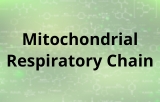The mitochondrial respiratory chain (MRC) is essential for cellular energy production, driving ATP synthesis through oxidative phosphorylation (OXPHOS). Traditionally viewed as individual complexes (I to IV) operating independently, recent discoveries have revealed that these complexes form higher-order assemblies known as respiratory chain supercomplexes (SCs). These SCs primarily consist of complexes I, III (as a dimer, CIII₂), and IV, and their organization is crucial for efficient electron transfer, minimizing reactive oxygen species (ROS) production, and adapting mitochondrial function to metabolic demands.
Background on Respiratory Chain Supercomplexes
Respiratory chain supercomplexes were identified through biochemical techniques such as blue native polyacrylamide gel electrophoresis (BN-PAGE), which preserves native protein assemblies during solubilization with mild detergents like digitonin. These assemblies, often called "respirasomes," facilitate substrate channeling and kinetic advantages in electron transfer, potentially enhancing mitochondrial respiratory efficiency and reducing oxidative damage. The dynamic assembly and disassembly of SCs reflect cellular metabolic states and have been implicated in various diseases including neurodegenerative disorders, mitochondrial myopathies, and cancer.
Applications and Significance
- Metabolic and physiological studies: The assay kit helps elucidate how SC organization adapts to metabolic shifts, such as changes induced by exercise, substrate availability, or disease states.
- Disease research: Alterations in SC assembly have been observed in neurodegenerative diseases (e.g., Alzheimer’s, Parkinson’s), mitochondrial myopathies, Barth syndrome, and cancer, making SC analysis a valuable biomarker for mitochondrial dysfunction.
- Drug discovery and toxicology: Screening compounds that modulate SC stability or activity can identify potential therapeutics targeting mitochondrial bioenergetics.
- Mitochondrial biology: The assay supports research into the role of assembly factors, genetic mutations, and post-translational modifications affecting SC formation and respiratory efficiency.
The Respiratory Chain Supercomplex Assay Kit is a powerful tool that integrates mitochondrial isolation, native electrophoresis, enzymatic activity assays, and immunodetection to analyze the assembly and function of respiratory supercomplexes. By enabling the study of these supramolecular structures in small or precious samples, the kit advances research into mitochondrial physiology, disease mechanisms, and therapeutic interventions targeting mitochondrial bioenergetics.








